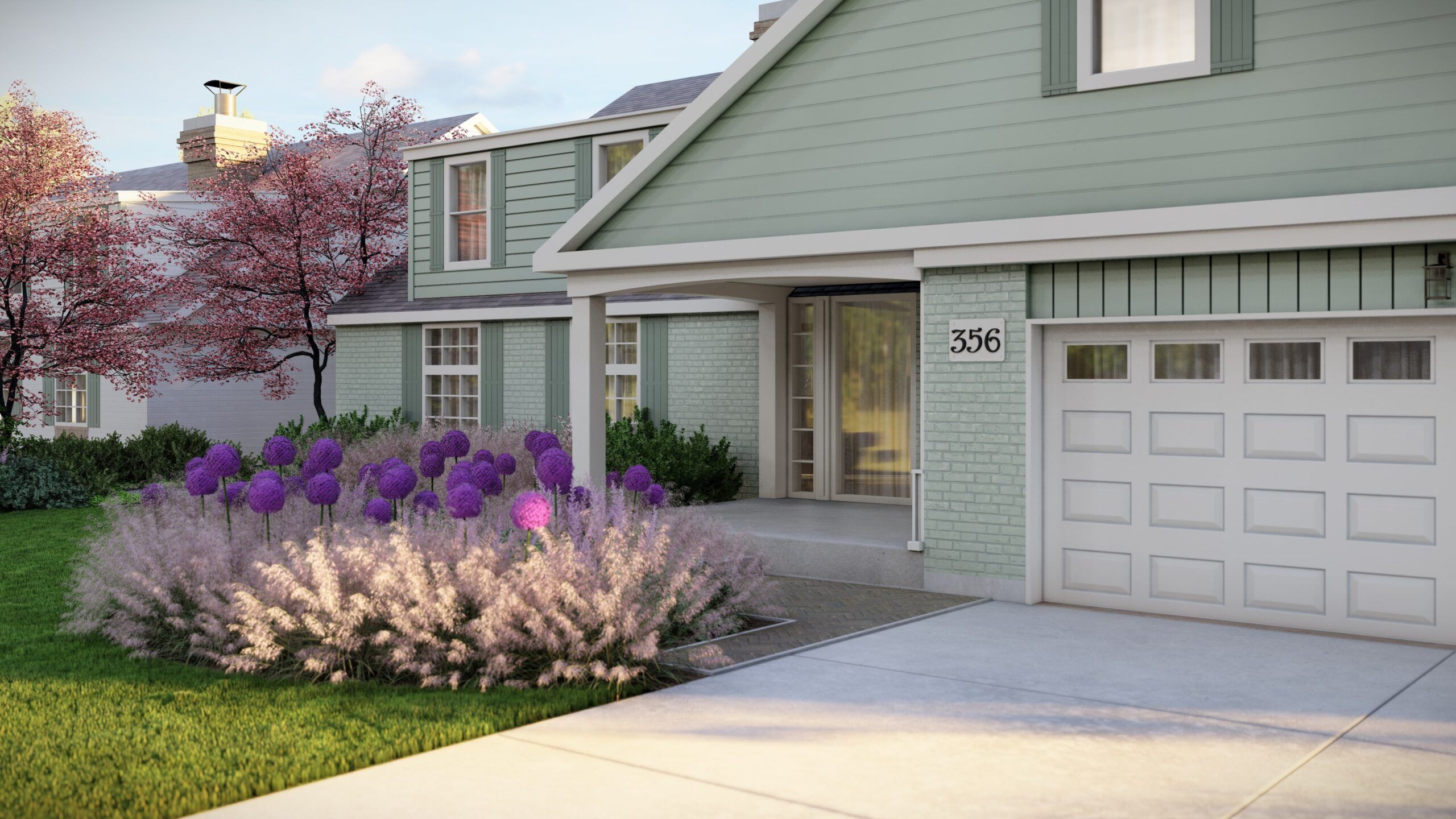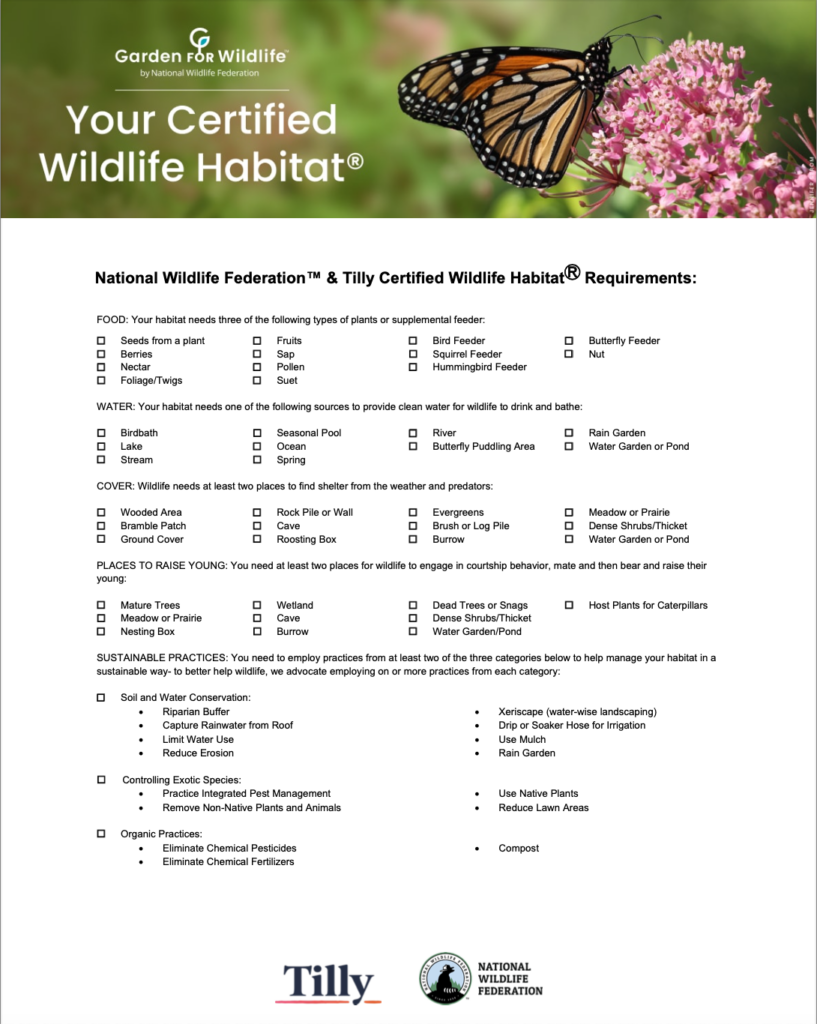What Does a Certified Wildlife Habitat® Yard Look Like?
By Axis Fuksman-Kumpa • September 29, 2022

National Wildlife Federation™ x Tilly
Tilly can design your yard to qualify as a Certified Wildlife Habitat® with the National Wildlife Federation™, which is proven to help biodiversity, water conservation, sequester carbon and much more… But what exactly is a Certified Wildlife Habitat®? And how difficult is it to create one in your backyard? These are questions we are frequently asked so here we will dig into one client’s journey to have their yard designated a Certified Wildlife Habitat®! Read more to learn about Tilly clients, Katie and Mike, and their new landscape!
What Makes a Certified Wildlife Habitat®?
The Certified Wildlife Habitat® program was created by the National Wildlife Federation™ to help bring nature back into developed areas. We currently lose one million acres of wildlife habitat to suburban development every single year in the United States, which devastates native plant and animal species. The National Wildlife Federation has established a set of simple ecological standards that can double the amount of wildlife in certified landscape designs.
A Certified Wildlife Habitat® yard must include a few forms of the below items:
- Food: Native plants provide the best food source for wildlife to thrive. Supplemental food may be provided for backyard birds especially in the winter.
- Water: All animals need water to live, and everything from a birdbath to a pond can keep their thirst quenched and bodies clean.
- Cover: Good cover shelters animals in bad weather and provides places to hide from predators—or sneak up on their prey.
- Places to Raise Young: Raising a baby is hard work for parents in the wild, and a habitat that can meet all their babies’ needs will help support the next generation.
- Sustainable Practices: Maintaining your landscape in a way that’s low-impact on the surrounding environment is key for your local ecosystem.

Landscapes that meet these standards have been shown to dramatically improve conditions for wildlife and humans alike! Lower soil erosion, better water conservation, higher biodiversity, and better air quality are just the start. You can read more about the benefits straight from the National Wildlife Federation.
The National Wildlife Federation provides Tilly’s landscape design team in-depth training on their ecological standards so we can incorporate the required elements into client’s yards. Tilly then submits their name for certification and covers the fee! This means less time spent on paperwork and more time spent watching the wildlife out your windows.
“Chances are you never thought of your garden--indeed, all of your property--as a wildlife preserve that presents the last chance we have for sustaining plants and animals that were once common throughout the U.S. But that is exactly the role our suburban landscapes are playing."
-Douglas W. Tallamy, Nature’s Best Hope
A Certified Wildlife Habitat Landscaping Plan
So what does a Certified Wildlife Habitat® look like in practice? Let’s break down a Tilly client's plan so you can see what it looks like! Tilly recently worked with a couple in Illinois named Katie and Mike who had their yard certified through Tilly’s online landscape design process.
Landscape Design Goals
After Katie had spent 2020 creating her own pollinator garden, a big move to a new house meant they were starting from scratch with their landscape. This blank slate afforded a new opportunity to explore pollinators and wildlife-friendly landscaping!
They presented their landscape designer Kim with a few requests for their backyard and front yard landscaping. They wanted:
- A naturalistic landscape design that took both stylistic and ecological inspiration from their local flora
- To incorporate some of the major existing features on their new plot, including several mature trees and a large boulder
- A space that catered to the whole family—parents and kids included
- A sense of privacy to enjoy their outdoor space in peace


What Their Designer Gave Them
Kim gave Katie and Mike everything they asked for and more in an inviting, cottage-style design that has a little something for everyone—while exceeding the standards for a Certified Wildlife Habitat®.
The front yard features an abundance of color and texture thanks to the bold purple blooms of alliums and sprays of ornamental grasses that stand out against the soft green of their home. A charming stepping stone path nestled between the plants leads through the side yard into a feature-packed backyard.



An expansive patio is home to multiple zones for entertaining, including a dining table placed under a natural wood pergola to provide gentle shade from the full sun. After dinner, the family can move to cozy seating around an outdoor fire pit to roast marshmallows. A dreamy hot tub completes the patio area and strategically-placed privacy screens allow Katie and Mike to kick back and enjoy the view of the stars without worrying about neighbors’ prying eyes.


The patio opens onto a lawn that provides plenty of space to play while the border of the property is framed with more hardscape and softscape features. Mature trees serve double duty, providing a perfect place for animals to raise their babies and hiding away a play set for the kids and a storage shed for the grownups.

The boulder that could have easily been an eyesore was turned into the centerpiece of a naturalistic sandbox for the kids to play in. A selection of surrounding stones and logs help to make the boulder look at home and provide a wealth of nooks and crannies for small wildlife to shelter in.


Meanwhile, a butterfly puddling area nestled between the sandbox and plants provides a perfect area for insects and small animals alike to rest and refuel. As an added bonus, it’s within view of the family play areas so they can enjoy their own backyard nature documentary.


The design becomes even more impressive when you consider the plants used throughout the softscape. 95% of the plants in their design are native or cultivars of native species! Biodiversity is shown to improve dramatically when just 50% of the plants are native, so this selection is a major boon to local wildlife. While true native plants are always the first candidates for Certified Wildlife Habitat® designs, sometimes cultivars are more practical.
For instance, the Saskatoon Shadbrush (Amelanchier alnifolia) is an amazing native North American shrub that provides shelter and a wealth of tasty berries for wildlife. However, the wild varieties can grow to 10 feet tall and spread into tenacious thickets—which isn’t ideal for residential landscaping. A cultivar called the Regent Serviceberry (Amelanchier alnifolia ‘Regent’) has been bred to have all the amazing fruit of its predecessor while staying a more manageable size—perfect for this landscape.
This emphasis on plants that can provide for the wildlife is found throughout the landscape. Blue Giant Hyssop (Agastache foeniculum) is a native plant that attracts butterflies, hummingbirds, and beneficial bees and native Swamp Milkweed (Aesculus incarnata) provides food and shelter for monarch butterfly adults and caterpillars. Ornamental grasses and dense shrubs including native Gray Dogwood (Cornus racemosa) are strategically placed on the edges of the property where they’ll be relatively undisturbed by people. They can remain untouched all winter long and will provide year round visual interest and a safe home for animals to raise their families.



Kim’s expert work in this design shows that a Certified Wildlife Habitat® isn’t just for the wildlife—it can be a beautiful, livable space for people too. The best sustainable landscape designs provide the best of both worlds for humans and the environment as we share our spaces and our homes.
Feeling inspired? You can start small by adding native plants to your landscape—check out the National Wildlife Foundation’s™ own online native plant store. Also consider adding a water source for thirsty pollinators or you can get expert help from Tilly to think of creative ways to incorporate the requirements to create a Certified Wildlife Habitat® in your space!
To learn more about the impact your yard can have on the environment we also recommend checking out Nature’s Best Hope by Douglas W. Tallamy, an inspiring read on how conservation can start with you.
“In the world I envision, landscaping practices will no longer degrade local ecosystems; landscaping will become synonymous with ecological restoration.”
- Douglas W. Tallamy, Nature’s Best Hope



Read more about: Landscape Design Tips, About Tilly